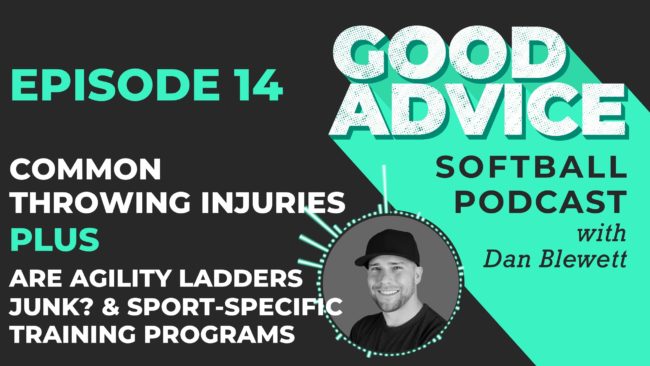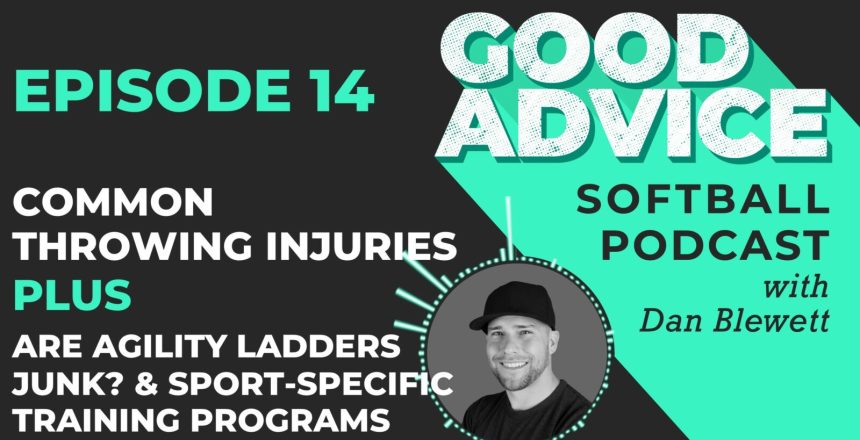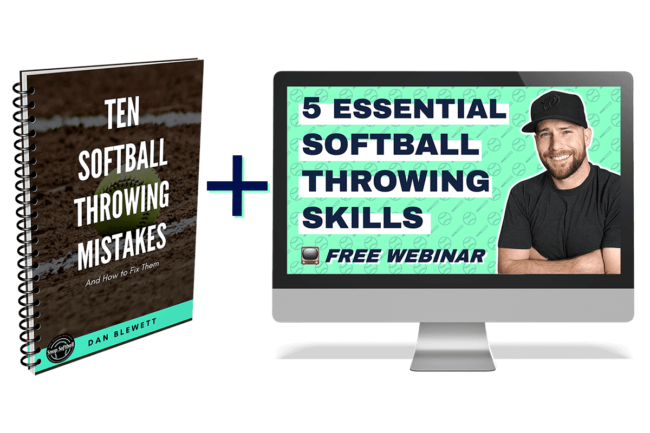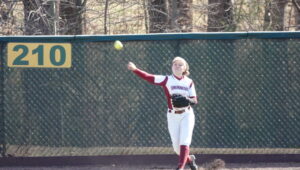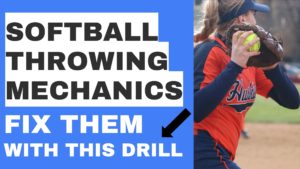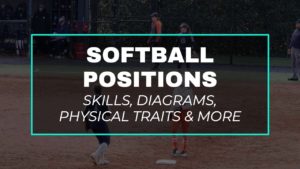*This article may contain product links which pay me a small commission if you make a purchase. Learn more.
In this episode we cover common types of softball shoulder injuries and how softball players can train to prevent them. We also discuss the ever-popular agility ladder, and whether or not they actually help players run faster or improve foot speed. Lastly, the term “sport-specific” gets thrown around a lot…does it actually mean anything?
To submit a question for the Good Questions Q&A segment, make a voice recording and email it to Dan at hello@danblewett.com. Want to support the show? Enroll in one of Coach Dan’s online throwing courses or his mental skills course. Use code GOODADVICE to save 20% on any course, just for being a listener. Sign up for Dan’s Email list and get his free throwing eBook, and follow up with him on the interwebs: YouTube Channel | Twitter | Snapsoftball.com
Podcast: Play in new window | Download
Subscribe: Apple Podcasts | Spotify
Full Transcript: EP14 Good Advice Softball Podcast: Common Softball Shoulder Injuries; Do Agility Ladders Work? Is Sport-Specific Training a Real Thing?
Welcome back to the good advice softball podcast. I’m Dan Blewett in today’s episode, we’re going to cover three topics. First. We’re gonna talk about some common shoulder injuries, shoulder ailments that softball players often get. Second, we’re going to talk about agility, ladders. Do they actually work for developing foot speed and quickness and sprint speed, all that stuff.
And lastly, we’ll talk a little bit about sports specific training and whether this is, Hey, that actually exists. And B if you actually need to seek it out for your daughter’s training. Okay. So let’s talk about some common shoulder injuries and, uh, you know, throwing and pitching and how they all sort of tie together.
So. There’s a couple of things to understand about the climate of throwing injuries. Number one, there’s a lot of research done on baseball pitchers. So pretty much all of that is sort of extrapolated to softball. We’re all humans. Obviously the ball is different. It’s a lot heavier in softball. It’s a lot larger, you know, it’s a 6.7 to 7.2 ounces versus five ounces for baseball.
So there’s some differences, right. But. Essentially, there’s not that many differences as far as like where we produce stress, you know, the, the body parts that are most at risk, but here’s yeah. The one, the two main factors, um, for, well, the three main factors for injury. So number one is ball velocity, ball velocity, highly correlated with the shoulder verus torque, which that is the torque.
Created from the shoulder as it rotates, super explosive to throw the ball. So the arm lays back into that sort of like gross looking position. Right. And then it explodes forward. So that towards is very, very difficult on your body. It’s not really, you know, we say that it’s a natural motion. I suppose humans have been throwing objects for a long time, but it’s not a healthy motion.
Whether it’s something that we’ve been doing for a long time as humans, or not, at least not a really high velocity, she’s the way baseball, pitchers throw. So the reason I’m mentioning that is that the harder you throw. The more exposed you are to injuries. So softball is a little bit protective in a sense because the ball is heavier.
And so it can not be thrown nearly as hard for me as a. A former baseball guy who could throw into the mid nineties. I can throw a softball a little bit of it. 80. I think my peak was 84. Uh, it’s hard to remember, but I know I could get it above 80 and that made my arm feel absolutely terrible. Number one, throwing it that hard.
Um, but B 80 is not really that fast. It’s fast enough to, you know, it’s, it’s fast enough to hurt your arm, but not nearly as many pitchers who are not overused hurt their arms, throwing 80 ish. So obviously the harder you throw the, uh, the, the higher that stress goes up now, it’s also very individual. So what stress, the stress, you know, like Sally’s shoulder and sh and Sally’s elbow could handle, might be much greater than the stress that Tina’s shoulder can handle.
So there’s not just one level of. Stress that is, uh, you know, like if you reach this point, you know, if we were to measure it, that if you throw this hard and Rav, this amount of stress on your arm, that you’re going to blow your arm on, it’s different for everyone. Some players can be, can go really long, have long careers, uh, with more stress than other players.
Do you have very short careers because of injury? So it’s, it’s highly. Specific, but the big thing to know is the harder you throw, the more it’s it’s unfortunately, a double edged sword. The more obviously performance you get, right? It’s a, you can make a lot more plays when you throw harder, but you’re adding speed.
Just kind of like a car. If you drive your car faster, the wreck is gonna have more energy. It’s going to be potentially more deadly. So that’s one thing to note a number two were used as a huge factor. I think we all understand that. Um, I know in softball, we sort of will leave, uh, have this naive idea that softball pitching there is like no overuse that you can just throw, you know, 500 pitches in a weekend.
Uh, that’s not really true. More and more research is being done. That’s sort of debunking that. So overuse is a big thing. Obviously a softball games. There’s a lot of just overhand throwing. You can play six games in a weekend tournament, no sweat. That’s a lot of throwing. And so overuse is one of the big ones, especially for girls to play multiple sports.
So if you’re a basketball player was basketball, doesn’t bleed over nearly as much. Um, cause obviously it is a winter sport or if you’re a volleyball player, that’s the bigger one where you’re hitting a ball. Another obviously another object, um, Obviously the volleyballs have written a soft ball. You’re colliding with it with your arm.
You’re not actually throwing it. And typically volleyball season has a decent overlap with at least training off season training for softball. So that’s a tough one. Lots of girls that we worked with over the years who played volleyball had. Consistent shoulder problems because they were constantly doing both a good, valuable practice for two hours, then have softball practice a day later and their arms are just exhausted.
So overused is a big one and it’s not exclusively games. Like I said, it can also be the whole scope of your training. So multiple sports included. Basketball also can be tough, not nearly as big deal as, as volleyball. Uh, just because you know, your arms are up overheads. Your shoulders can, can be tired if you’re shooting 150 baskets, um, over a long practice, you know, that’s, that’s not insignificant load on your shoulders.
So overused. This is obviously a big one. And the other big one that can tribute to shoulder problems, especially in school players is his shoulder laxity. So laxity just means. Your shoulder joint just isn’t that stable, it’s kind of loose. Most girls have this, uh, because girls have lower testosterone as compared to boys, they tend to have less muscular strength and so less muscular strength just tends to mean their joints are just a little bit looser in general, and they just have a more natural flexibility, uh, because of some other hormonal factors as well.
So with, with all of our female athletes that we worked with over the years, we were always. Highly stressing rotator cuff work, and lots of upper body training, just because we want their shoulders to be strong and stable. And that just means when the shoulder, um, when, you know, the, the upper arm, the, the, uh, the humorous one that’s held in the shoulder socket, we want those muscles really like clinging to it and holding it on tight.
Right. So the, uh, that’s a really important factor. So those are three big ones. Those are by no means the only injury factors. Um, but those are big ones. So overused, shoulder laxity, uh, and then ball speed. So actually when you have really poor throwing mechanics and softball, at least I don’t think that it really exposes you to more injury.
Because the ball speeds are so low. Uh, it’s almost like your body is so inefficient that it just, you’re not going to still going to produce that much stress now. And over the years I’ve seen a lot of players and I haven’t seen a tremendous correlation between. Arm pain and how bad their throwing mechanics are.
Really. I see lots of girls with bathroom, mechanics who don’t have arm pain. And then I see some girls with good throwing mechanics that do have arm pain, and I see everything in between. So it’s not necessarily again because of ball speeds. If you had terrible mechanics, but you’re throwing a ball 90 miles per hour, you’d be in trouble for sure.
But usually bad mechanics hold you back from throwing very hard at all. And then again, lower ball speeds are protective on the body. So it’s not like you’re gonna, you’re going to blow out your elbow, ligament throwing 44 miles per hour across the diamond. And you’re not really going to probably tear your labor from doing that either.
Unfortunately. Um, well, not unfortunately, unfortunately, but you, I hopefully you get what I mean, it’s, uh, you know, as you throw harder and your mechanics actually improve, you actually put more stress through it. So it’s, it’s a, it’s a weird conundrum a little bit. So. That being said, let’s talk about some, some actual injuries that players get.
The thing to know is most software will not hurt their UCL, like baseball players. Like I’ve had Tommy John surgery twice, which is an elbow ligament reconstruction surgery. When you throw hard enough or if you’re overused or other factors. You can tear that elbow ligament, that elbow ligament that provides stability in your elbow.
Um, but very few softball players end up getting the injury again, because I think probably the number one reason is just ball speeds, how hard they throw are just lower. If you’re really hard throwing softball player, you throw 65. And that just is, is not very hard. So, uh, so UCL tears in the elbow ligament are generally caused by significant overuse and competitive throwing, much more so associated with baseball, pitchers and position players.
Position players in baseball are still very infrequently getting Tommy John surgery, uh, or suffering major UCL injuries or partial tears. So it’s really more exclusively limited to baseball players. And then when you also then go to softball, Because again, ball speeds are low UCL tears. They’re not really something that’s significantly a worry.
The bigger one is our, our growth plate tendinitis and labor tears. So labor room tears are, so you have a little piece of tissue and your shoulder called your labor room. It helps sort of deepen your socket. So it helps kind of keep your, it kind of wraps around the head of the bone in your shoulder socket and just provides a little bit more depth because your shoulders very shallow.
It’s kind of like a golf ball on a tee is the common analogy. So, if you imagine this piece of tissue wraps around the golf ball to kind of hold it in place a little bit better. So the labor room is protected by good shoulder stability. So the stronger your shoulders are, the more rotator cuff work you do.
And the lesson again of that natural light, actually that you have the more your shoulders held stable in that joint. And so it’s the bones not banging around and, and sort of like. Damaging the labor, because it’s sort of like moving and jostling around, just like if you know anything, any, any machine, any mechanical device when it has loose things rattling around in it, it eventually sort of destroys itself, right?
Like if your engine has a, has a rod loose, it’s going to eventually destroy the whole engine. So that’s pretty much the, the way to think about labor injuries. They’re highly preventable, not always preventable by any means, but they’re highly preventable. And in baseball, Lieberman, shoulder injuries have been on way, way down the last five, 10 years, because we know so much more about how to care for and strengthen the shoulder.
Compared to the elbow, which is actually sort of like a passive structure. So labor material are highly preventable with a good rotator cuff and shoulder program that a player is going to do three or four days a week. Um, probably from when they’re like 13 and up, and it could be younger if they start having shoulder problems a little earlier, that just might be an indicator that they need a little bit more of it.
So labor and tears are, you know, they can require surgery most of the time, they should not go through surgery because, and again, that’s not advice from me. That’s just saying, you know, most doctors will agree that labor, labor room surgery outcomes are not great. So most doctors try to opt for. Rehab first and exhaust all efforts before undergoing surgery.
Um, growth plate is a very common one. We would see one or two players get a growth plate injury every year in my Academy. And I’m not embarrassed to admit that because, you know, number one, you can’t prevent every injury as a, as a strength coach or a coach in general. Number two, uh, it’s really tied to.
You know, like it says growth. So when your growth plates are open, which is until you’re, you know, growing you’re done growing there, they can just, they’re going to take some of the stress of whatever you do. So some players never have a growth break play problem. They played tons of softball. They played tons of whatever sport they lift.
They run, they do all this crazy stuff. They’re climbing from trees and they never have any growth plate issues. Other athletes. They throw a little bit and they have growth plate inflammation, their elbow hurts. So it’s typically in the elbow or the shoulder where you’d see it. And, uh, it’s not basically what all the doctors have always come back with is they say they can do anything that doesn’t cause them pain.
So if they can do a pushup without pain, no problem. If a pushup or, or throwing a ball. Continues to give them pain, then it’s going to continue to set them back. So growth plate, um, growth plate injuries, whether it’s growth, plate inflammation, or a growth plate fracture, which you want, want to avoid a, which can they require surgery, then we’ll have to go in and put a screw into to reattach it.
Um, there, you just need to be cautious. So any little bit of any little bit of elbow pain or shoulder pain should be looked at and, uh, they shouldn’t be, or they should evaluate it with an X Ray to see if it might be growth, blatant inflammation, because if it is growth, growth plate inflammation, then you want to take that for six or eight weeks off, which unfortunately isn’t necessary.
So let the inflammation go down because if you contain to aggravate it and that’s doing things that aggravate it. So again, you could be at a, you know, hit or, or lift weights. Lots of kids could, could lift weights perfectly fine. They just couldn’t throw, or they couldn’t swing a bat. So it just depends.
But as long as you don’t continue to aggravate, it it’ll heal. If you continue to aggravate it, it’ll eventually probably crack and then you’ll have an issue and you might need surgery. So a growth plate injuries are definitely something to take seriously. Uh, the prognosis is not terrifying when, you know, if it’s just a little bit of inflammation, you just give it some rest and don’t aggravate it, but you can continue to be active if it doesn’t bother.
Um, but that’s just something to be aware. Last one is, is tendonitis. This is kind of a catch all term. Um, and it can just be, Hey, you know, we’ve got some, again, some laxy in the shoulder. My shoulder’s pretty overworked, uh, or I just don’t have the strength in, and my mechanics maybe are contributing to the issue.
And so my shoulders just inflamed and angry at me. And that kind of falls into the scope of tendonitis. So typically when you, when you get tendonitis, you want to address something else, which is, do I need to start to strengthen my shoulder more? Do I need to get an arm care program? Do I need to look at, you know, other issues with my body.
Like what’s putting this extra stress on my arm and my throwing too much. Is there an overuse issue? So anytime you go in for arm pain, be sure to check it out. Not from the sense of like, let’s just get a bandaid for it. And just rest it, but let’s also, let’s also reevaluate what we’ve been doing because maybe, you know, six games in a weekend just isn’t good for you.
So, and that might be the chief cause. So hopefully this overview of, of, uh, of common throwing injuries is helpful. It’s good. As a parent, just to have, uh, a general knowledge of what’s going on. If your daughter has pain,
Alright, talk a little bit about agility ladders. So, uh, as a former strength coach, uh, Academy owner, while I’m still a strength coach, not an Academy owner anymore, we would get parents a good amount. They’d come and say, Hey, my daughter needs to get faster. She really wants to improve her, her home the first time.
And you’re like, we really want to, you know, can she do some agility, ladders? Like we really want to do some this and that and make sure she gets faster. So agility ladders have been, they’ve gotten the idea of strength coaches for the last five, 10 years. Uh, because it’s kind of, it kind of falls under the term.
Eyewash eyewash is unfortunately it used to be a great term, but now, now it’s been overused. Um, eyewash wash is just when you’re doing something because it looks good, but doesn’t actually do anything. I wash just in the, uh, in the, in the baseball slang and softball slang realm. Also just sorta means when you’re going through the motions, just to look good in front of your coach or your teammates.
So. You know, like you’re just goofing off and then coach shows up and then you just immediately jump on the tee and you start swinging that, that girl’s all eyewash. She only works hard when coach is watching. So anyway, the, uh, as far as agility, ladders go, the way you develop sprint speed is this, you learn to put more force into the ground, just like a car.
If you put a bigger engine in it, it’s going to go faster. So you learned to put more force in the ground. You do that through strength training. So strengthening your legs, specifically, your quads, hamstrings glutes, right? And then how fast can you apply that force to the ground? So that’s where sort of plyometrics comes in and, uh, taking the strength that you built and learning to teach your body to someone at faster, through faster, um, neuromuscular factors.
So that’s sort of the cocktail. And then obviously the third part is do you’re running you’re sprinting mechanics. So having good sprint form makes you more efficient. So you apply more of your power fast. Into the ground, you know, at the right body angles and, and without running on your heels, stuff like that, you get your foot in the optimum position to take the next foot strike.
Running the spring mechanics are important, right? But then again, for all players, everyone’s going to have a little bit of a unique gait, the way they run. And some players can run faster than everyone else with subpar sprint mechanics, and some players going to have impeccable sprint mechanics and still be slower.
So those are, but it’s still obviously very important to have sprint sprint technique as part of your training. So. As far as agility, ladders go, they don’t do any of those things. They don’t teach you to apply force to the ground faster. So they don’t actually strengthen your legs. They don’t teach you how to apply force faster to the ground.
That’s only done through plyometrics really. Um, and plyometrics are typically not jumping up one thing, but actually jumping down from things. So when you jump off a box, Your body has to decelerate your body fast. And so it learns to fire its muscles faster to decelerate it. That’s why you can’t jump off a two story building and be okay because your body can’t decelerate the speed of your fall.
Fast enough, you could jump off like an eight foot thing, right. Or maybe like a 10 foot thing. But if you get above that, your body doesn’t have the strength to decelerate your body fast, but through plyometrics, jumping down from boxes and then quickly jumping back up, stuff like that, there’s lots of different types.
They teach your, your neuromuscular system to actually fire its muscles faster and summon more of your muscle muscle fibers, quick, more quickly. So a sprinter like Usain bolt. Is both incredibly strong and his body also can summon all that power. So it’s putting like 500 pounds into the ground in one 10th of a second.
For example, those are just numbers I’m making up, but that’s where someone else, if they put 500 pounds of force, the same metaphors as him into the ground and two tenths of a second. They’re slower because you saying bolt just hit it right off the ground that when one 10th. So that’s sort of, the formula is helpful asking you apply a lot of force into the ground very, very quickly.
So it, Julie ladders, again, they don’t teach your legs too. Become stronger through strength training. They don’t do that. They don’t teach your body to apply force morph more quickly. And Lynn, lastly, they obviously don’t work on a sprint technique. So foot speed is something that you can, you know, agility, ladders and the coordination.
They’re good for warmups. They’re kind of fun. So if they motivate athletes, that’s fine. We would use them in warm up sometimes. They’re good for young kids who are still learning to like have body control and just learning general athleticism kind of things we would do with, you know, the youngsters like six to eight.
But if you’re looking at sprint speed for the off season, you want to get faster agility, ladders. They’re just not the way to go.
All right. Let’s lastly, talk about sports specific training. So this was a Twitter conversation, uh, from a good friend of mine. Recently, he was sort of embroiled in this with other people, even with other strength coaches who were saying. As sports specific training is not really a thing. Well, it’s, it’s definitely a thing.
So here’s what sport-specific training is. So most athletes are going to do about 80%. Of the same exercises as any other athletes. So if you’re a swimmer, you’re a volleyball player, you’re an Olympic weightlifter, you’re a softball player. You’re still gonna do 80% of the same things because you’re a human being, right.
We’re all humans. And no matter what your sport, you need strength from the animal. You’re part of your side, the front part of your body and the rear of your body. So you’re going to need. Strong, but strong hamstrings, strong quads. You know, you need a strong core because that connects your lower half and your upper half, you need strong arms.
Right? So those things are all important. And we want to cover all the basic human movements, which are like pushing something away. Pulling something towards you, hinting at the hips and squatting. And so, you know, like bending at the knees, the hip hinge, um, push pull, or like the four basic movements. And then there’s obviously other sort of variations beyond that.
They get a little more granular. But in, in general, like any athlete on any good program is going to do those things. They’re going to do a mix of it, of hindering and squatting movements. That includes like lunges and squats, hinges, lumens include like dead lifts and deadlift variations and hamstring curls, stuff like that.
Yeah. Pushing exercises like bench, press dumbbell, bench, press pushups, pulling exercises as is, which are all rowing variations and different angles. So it chin up as an overhead row, obviously a seated row as a horizontal row, stuff like that. Every athlete is going to need to do those. So there really isn’t that much sports, but specificity in those core ones.
Um, but then again, you do start to get into it a little bit deeper. So with like a, a softball player, a dumbbell bench press is probably better for their shoulders than a straight bar dead, uh, or bench press. And a pushup is probably better then, you know, maybe dumbbell bench press at first. So. Those, that can be a little bit sport-specific.
Now the big thing is the 20%, uh, of things that every athlete’s not going to do. So if you compare a softball players, strength program to a swimmer’s program, A swimmer doesn’t really need to do rotational core exercises. They don’t really need to do a lot of, they do need to, some are rotator cuff exercises, but not really that many rotator cuff exercises.
They don’t really need to do that much grip strength either. Right. They’re swimming. So with a swimmer and I actually don’t really know what the extra stuff would be for a swimmer, cause it’s not my expertise, but, um, a swimmer’s program, isn’t going to have some of those things for softball. Whereas for a softball player, the 20% of things is going to be.
Probably some, some knee care, right? So it’s a female athlete. So we’re going to do some, uh, lateral hip strengthening to help prevent ACL tears. We’re also going to do a lot of grip strength cause you hold a bat. Grip. Strength is important for both swinging and for throwing. Um, we’re going to do a lot of rotator cuff work, as we mentioned before, because that’s going to protect you throwing arms because throwing arms are a big injury risk.
Uh, we’re also gonna do a lot of rotational core work, which is throwing medicine balls and also doing anti-rotation exercises for core stability because you swing a bat and you throw, and those are both rotations sure. Sizes. So those are the sports specific things that. It wouldn’t really make that much sense to program that in again, women’s program or to a soccer players program.
Like why do we need to put grip strength into a soccer players program? There’s not a significant need for that. You can certainly put some in there, but it’s certainly not a priority, right? We don’t really need to put money. The rotator cuff work into a soccer players program. They’re not really using their shoulders in the same overuse scenario that a softball players.
Sure. Certainly they need posture and rotator cuff is important for every person, but. Not nearly to the extent of a softball player. Right. And then why is this a soccer player need rotational med ball throws. They don’t right. They’ll throw some, some soccer throws in from out of bounds, overhead, but there’s not really a rotational component in softball, or I’m sorry, in soccer.
So you can see like, there’s definitely a difference between the two programs the way you do it. But again, the soccer player and the softball player are both gonna get a lot of glute exercises, core exercises, pushing, and pulling and legs and all that stuff. Um, and so there’s going to be, again that, that big overlap, but the really fine tuning things.
Those are the things that make a program sport-specific so, um, don’t be misled if you. Like sports. Specificity is not the biggest deal in the world, especially for younger athletes, but it does become a big deal, especially for softball because they do need arm care. They do need rotational work to help develop their bat speed and their throwing speed.
There are some definite needs that a good strength coach is going to put into a softball specific training program.
Well, that’s all the good advice I’ve got for today. If you enjoy the show and would like to support me while also helping yourself enroll today. And one of my online softball courses, my she’s got a Canon throwing courses come with pricing plans for any budget. And my resolute athlete, mental skills course will help your daughter or team build the mindset of a champion.
Enroll in any of my courses through the links in the show notes and save 20% with code good advice just for being a listener. Be sure to subscribe to my weekly email list where you’ll get updates on all my new videos and episodes, nearly 4,000 people get my emails and you should to sign up for the link in the show notes.
Lastly, who do you know, who can use some good advice? Please share this podcast with a friend, subscribe on iTunes, Spotify, or wherever you listen to podcasts and subscribe to my snap softball, YouTube channel, where you’ll find this podcast and hundreds of softball, instructional videos. Back when I was a player, I was always thankful for good coaches and good advice.
I’m Dan Blewett and I’ll see you next time. .

